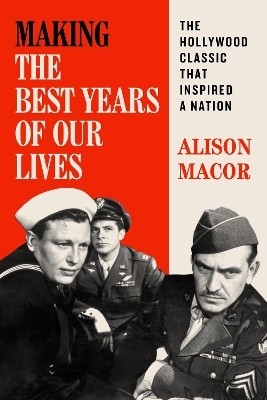
Making The Best Years of Our Lives
Seiten
2023
University of Texas Press (Verlag)
978-1-4773-2833-0 (ISBN)
University of Texas Press (Verlag)
978-1-4773-2833-0 (ISBN)
Released in 1946, The Best Years of Our Lives became an immediate success. Life magazine called it "the first big, good movie of the post-war era" to tackle the "veterans problem." Today we call that problem PTSD, but in the initial aftermath of World War II, the modern language of war trauma did not exist. The film earned the producer Samuel Goldwyn his only Best Picture Academy Award. It offered the injured director, William Wyler, a triumphant postwar return to Hollywood. And for Harold Russell, a double amputee who costarred with Fredric March and Dana Andrews, the film provided a surprising second act.
Award-winning author Alison Macor illuminates the film's journey from script to screen and describes how this authentic motion picture moved audiences worldwide. General Omar Bradley believed The Best Years of Our Lives would help "the American people to build an even better democracy" following the war, and the movie inspired broad reflection on reintegrating the walking wounded. But the film's nuanced critique of American ideals also made it a target, and the picture and its creators were swept up in the anti-Communist witch hunts of the late 1940s. In this authoritative history, Macor chronicles the making and meaning of a film that changed America.
Award-winning author Alison Macor illuminates the film's journey from script to screen and describes how this authentic motion picture moved audiences worldwide. General Omar Bradley believed The Best Years of Our Lives would help "the American people to build an even better democracy" following the war, and the movie inspired broad reflection on reintegrating the walking wounded. But the film's nuanced critique of American ideals also made it a target, and the picture and its creators were swept up in the anti-Communist witch hunts of the late 1940s. In this authoritative history, Macor chronicles the making and meaning of a film that changed America.
Alison Macor is a freelance writer and former film critic for the Austin Chronicle and the Austin American-Statesman. She has a PhD in Radio-Television-Film from UT Austin. She is the author of Chainsaws, Slackers, and Spy Kids: Thirty Years of Filmmaking in Austin, Texas and Rewrite Man: The Life and Career of Screenwriter Warren Skaaren.
Introduction
Chapter 1. Warstruck
Chapter 2. Every Veteran a Potential Mental Case
Chapter 3. The Way Home
Chapter 4. Underwater Again
Chapter 5. Fade on Kiss
Chapter 6. Pure Emotional Dynamite
Chapter 7. It’s All the Same Fight
Chapter 8. A Training Film for All of Us
Acknowledgments
Note on Sources
Notes
Bibliography
Index
| Erscheinungsdatum | 06.09.2023 |
|---|---|
| Verlagsort | Austin, TX |
| Sprache | englisch |
| Maße | 150 x 250 mm |
| Gewicht | 666 g |
| Themenwelt | Kunst / Musik / Theater ► Film / TV |
| Geschichte ► Allgemeine Geschichte ► Neuzeit (bis 1918) | |
| Geisteswissenschaften ► Geschichte ► Regional- / Ländergeschichte | |
| Sozialwissenschaften ► Kommunikation / Medien ► Medienwissenschaft | |
| ISBN-10 | 1-4773-2833-5 / 1477328335 |
| ISBN-13 | 978-1-4773-2833-0 / 9781477328330 |
| Zustand | Neuware |
| Informationen gemäß Produktsicherheitsverordnung (GPSR) | |
| Haben Sie eine Frage zum Produkt? |
Mehr entdecken
aus dem Bereich
aus dem Bereich
Giordano Bruno - ein ketzerisches Leben
Buch | Hardcover (2024)
C.H.Beck (Verlag)
CHF 41,85
das dramatische 16. Jahrhundert
Buch | Hardcover (2024)
Rowohlt Berlin (Verlag)
CHF 47,60


